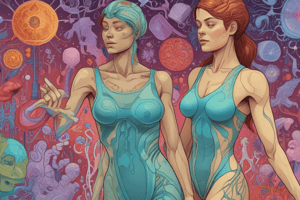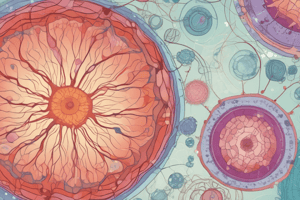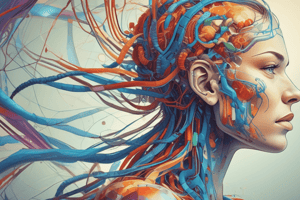Podcast
Questions and Answers
What is the relationship between organ systems and living organisms?
What is the relationship between organ systems and living organisms?
- Living organisms consist solely of organ systems without tissues.
- Organ systems are independent and do not interact within an organism.
- Organ systems are groups of similar tissues that form organs. (correct)
- Living organisms are composed of a single organ system.
Which process allows plants to convert sunlight into energy?
Which process allows plants to convert sunlight into energy?
- Fermentation
- Metabolism
- Photosynthesis (correct)
- Aerobic respiration
Which characteristic of life refers to the complex arrangement and functions within an organism?
Which characteristic of life refers to the complex arrangement and functions within an organism?
- Organization (correct)
- Responsiveness to stimuli
- Homeostasis
- Evolutionary history
How does the concept of homeostasis relate to stimuli?
How does the concept of homeostasis relate to stimuli?
What is considered the highest level of biological organization?
What is considered the highest level of biological organization?
Which of the following statements accurately reflects the role of biology in medicine?
Which of the following statements accurately reflects the role of biology in medicine?
What primary source of energy do almost all organisms rely on?
What primary source of energy do almost all organisms rely on?
What is the smallest unit of life that demonstrates the characteristics of living organisms?
What is the smallest unit of life that demonstrates the characteristics of living organisms?
In terms of biology, which of the following best describes the concept of 'homeostasis'?
In terms of biology, which of the following best describes the concept of 'homeostasis'?
Which of the following reflects the concept of 'acquiring materials and energy' in living organisms?
Which of the following reflects the concept of 'acquiring materials and energy' in living organisms?
Flashcards
What is Biology?
What is Biology?
The study of living organisms and their interactions with each other and their environment. It encompasses structure, function, growth, taxonomy, origin, evolution, and distribution of living things.
What are the characteristics of life?
What are the characteristics of life?
Basic characteristics shared by all living organisms, including organization, acquisition of materials and energy, homeostasis, response to stimuli, reproduction and growth, and an evolutionary history.
What is a cell?
What is a cell?
The smallest unit of life that can carry out all the functions of life.
What is homeostasis?
What is homeostasis?
Signup and view all the flashcards
What is reproduction?
What is reproduction?
Signup and view all the flashcards
Photosynthesis
Photosynthesis
Signup and view all the flashcards
Homeostasis
Homeostasis
Signup and view all the flashcards
Energy for Life
Energy for Life
Signup and view all the flashcards
Tissue
Tissue
Signup and view all the flashcards
Cell
Cell
Signup and view all the flashcards
Study Notes
Human Biology Introduction
- Biology is the study of living organisms and how they interact with each other and the environment
- Biology examines structure, function, growth, taxonomy, origin, evolution, and distribution of living things
- Biology has a direct impact on our lives, especially in medicine, where advances improve health care daily.
Biology and Medicine
- Biological knowledge is used to stop infectious diseases (e.g., flu, tuberculosis, malaria)
- Cure genetic disorders (e.g., cystic fibrosis, muscular dystrophy)
- Study the Earth's ability to sustain the human population, which is increasingly strained.
The Characteristics of Life
- All living organisms share basic characteristics: organized, acquire materials and energy, homeostatic, respond to stimuli, reproduce and grow, and have an evolutionary history.
Organization of Living Things
- Living things are highly organized, from cells to organ systems.
- Single-celled organisms are self-sufficient
- Multicellular organisms have cells organized into tissues, organs, and organ systems
- Levels of biological organization extend beyond the individual organism: population, community, ecosystem, and biosphere
Acquiring Materials and Energy
- Organisms require energy for life processes.
- Most energy on Earth comes from the sun
- Plants capture sunlight and produce complex molecules (glucose) through photosynthesis
- Animals obtain energy by consuming plants or other animals.
Homeostasis
- Homeostasis is the ability of a cell or organism to maintain internal conditions.
- Human organ systems work to maintain homeostasis
- For example, maintaining body temperature (around 36.5-37.5°C).
Living Organisms Respond
- Homeostasis requires responding to stimuli
- Responses to external stimuli are often apparent as movement.
Reproduction and Development
- All organisms reproduce to create copies
- Unicellular organisms reproduce through simple division
- Multicellular organisms involve sperm and egg union, followed by cell division and maturation.
Evolution
- Evolution is the process by which populations change over time
- Natural selection is the mechanism driving evolution
- Individuals with advantageous variations are more likely to survive and reproduce, passing on their traits.
Classification of Living Organisms
- Living organisms are classified using a variety of methods to study relationships
- This classification system is called taxonomy
- Carolus Linnaeus's system, using binomial nomenclature is important for classifying and organizing known organisms
Linnaean System of Classification
- The Linnaean classification system is a hierarchical system with levels.
- In order from highest to lowest: Kingdom, Phylum, Class, Order, Family, Genus, Species.
- Scientific names are written in italics, with the genus capitalized and the species in lowercase.
Domains of Life
- Living organisms are categorized into three domains: Bacteria, Archaea, and Eukarya
- Bacteria and Archaea are prokaryotes that do not have a nucleus
- Eukarya includes organisms with a nucleus. (i.e., protists, plants, fungi, and animals)
Investigating a Problem-Scientific Method
- Investigating a problem follows a systematic approach called the scientific method.
- Make observations.
- Form a hypothesis.
- Research background information.
- Generate a prediction
- Conduct an experiment.
- Collect and analyze data.
- Draw conclusions.
Critical Thinking
- Critical thinking involves systematically and objectively judging information.
Studying That Suits You
Use AI to generate personalized quizzes and flashcards to suit your learning preferences.





